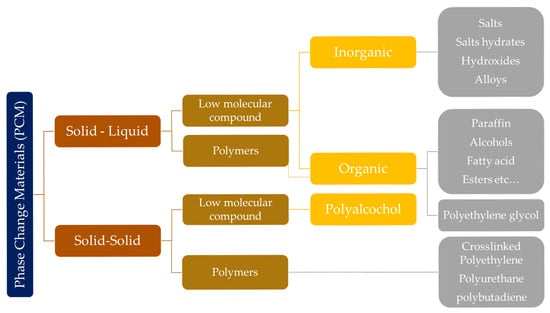Abstract
Energy demand in the building sector has drastically increased due to rising occupant comfort requirements, accounting for 30% of the world’s final energy consumption and 26% of global carbon emissions. Thus, to improve building efficiency in heating and cooling applications, phase change material (PCM)-based passive thermal management techniques have been considered due to their energy storage capabilities. This study provides a comprehensive review of the research on PCM applications, types, and encapsulation forms. Various solutions have been proposed to enhance PCM performance. In this review, the authors suggest new methods to improve PCM efficiency by using the multilayered wall technique, which involves employing two layers of a hybrid bio-composite—specifically, the hybrid hemp/wood fiber-reinforced composite with a polypropylene (PP) matrix—along with a layer of PCM made from spent coffee grounds (SCGs). Previous studies have shown that oil extracted from SCGs demonstrates good thermal and chemical stability, as it contains approximately 60–80% fatty acids, with a phase transition temperature of approximately 4.5 ± 0.72 °C and latent heat values of 51.15 ± 1.46 kJ/kg.
1. Introduction
For the first time in centuries, five megatrends are concurrently impacting the world: climate change, demographic shifts, technological disruption, a fracturing world, and social instability. As we move into the future, organizations must strategically address each of these areas. In particular, demographic shifts and urbanization have made significant contributions to the excessive use of primary energy and massive emissions of carbon dioxide (CO2), leading to energy depletion, global warming, and climate change. Nowadays, investigations are being conducted worldwide on various energy production, energy storage, and renewable energy technologies [1].
Energy production accounts for around three-quarters of global greenhouse gas emissions. Moreover, not only is it the largest driver of climate change, but the burning of fossil fuels as well as biomass has also come at a large cost to human health [2]. In addition, projections indicate that CO2 emissions could increase by more than 50% by 2050 [3]. Among the most energy-consuming sectors is the building sector. In fact, it accounts for 30% and 26% of the world’s final energy consumption and global carbon emissions, respectively [4,5,6]. Furthermore, as shown in Figure 1, building systems, particularly heating, ventilation, and air conditioning (HVAC), along with lighting, account for up to 60% of the total building energy consumption—a percentage that continues to rise through the years [1,7,8]. In particular, the energy demand for cooling is projected to increase significantly in 2040 and 2060, driven by the growing need for indoor comfort and the effects of climate change [9].
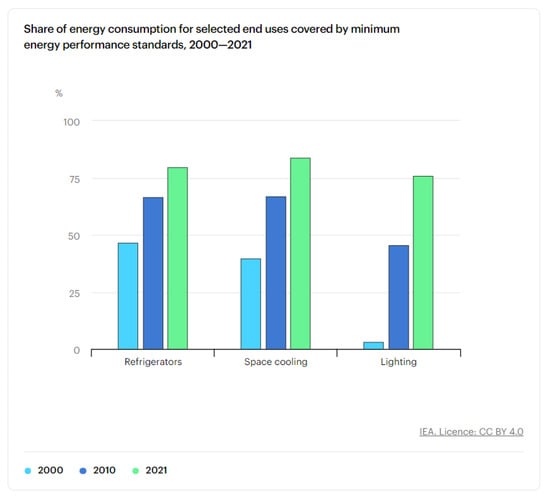
Figure 1.
Trends in rising energy consumption in the building sector: a comparative analysis from 2000 to 2021 [5].
According to the 2022 Outlook of the International Energy Agency (IEA) [10], global building energy consumption is projected to increase by an average of 1.5% per year between 2012 and 2040 [11]. This trend is expected to accelerate between 2025 and 2027 due to the growing energy demand from data centers and digital networks within the building sector [4]. Besides, one-third of global energy and process-related CO2 emissions originate from both direct and indirect emissions in the building sector, resulting in a large carbon footprint. In total, 10 Gt of emissions were attributed to building operations, marking an increase of 2% compared to 2019 and 5% compared to 2020. These emissions are distributed as follows: 8% result from the direct use of fossil fuels in buildings, 19% from the generation of electricity, heating, and cooling for buildings, and 6% from the manufacture of cement, steel, and aluminum used in construction operations—an activity that saw a 34% rise between 2010 and 2021 [5,12].
Thus, the transition toward more sustainable, cleaner, efficient, and renewable energy technologies in the building sector remains a necessity for seeking potential solutions to achieve Net Zero Emissions in Buildings (ZEB) by 2050. Therefore, the next few years will be critical for implementing the necessary measures in both new and existing buildings to reach the zero-carbon-ready target as early as 2030 [5,7]. As shown in Figure 2 and Figure 3, this alarming situation made many countries take action and invest in the clean green sector, which saw a 15% increase in 2021. As a result, over 1828 related policies, strategies, and scenarios have been suggested worldwide to reach the 2030 target [13] and to align with the UN’s Sustainable Development Goals, including the “Clean Growth Strategy” adopted by the UK, the “13th Five-Year Plan” by China, and the “2030 Energy Strategy” by EU states [14,15,16].
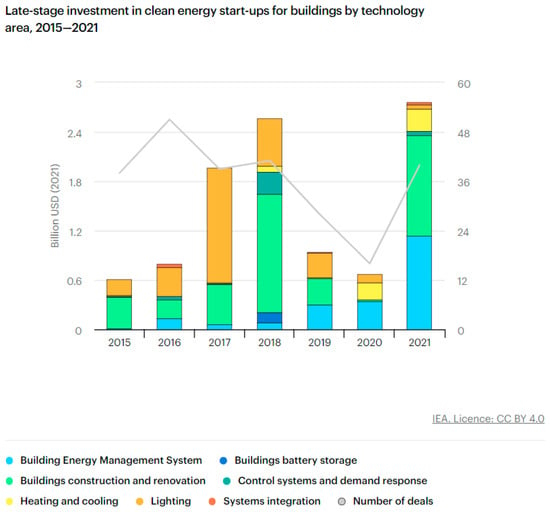
Figure 2.
Investment driving clean energy transformation in the building sector: a 2015–2021 analysis [5].
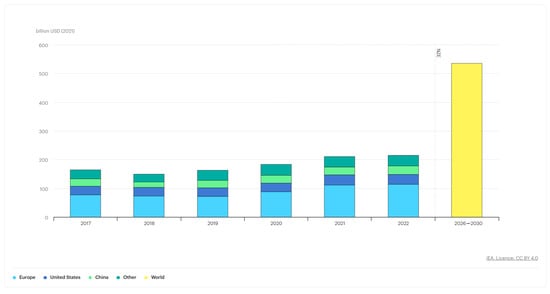
Figure 3.
Predicted evolution of global investment trends in energy efficiency and clean technologies in the building sector [5].
This review aims to investigate the importance of latent heat thermal energy storage technology by using phase change materials, specifically spent coffee grounds (SCGs), as a storage material. The proposed study focuses on using multilayered techniques, specifically a double layer of a hybrid PP-MAPP/hemp/wood composite, to enhance the performance of the PCM incorporated into the building envelope.
2. Thermal Energy Storage (TES) Technology
Researchers have conducted various investigations on renewable energy-based systems, each within their respective field of expertise, to reduce heating and cooling peak load. Among them, Hmida et al. [17] investigated the use of photovoltaic–thermal (PVT) systems to produce heat, cooling, and electricity for buildings. The authors concluded that the photovoltaic–thermal (PVT) double-pass collector can achieve an annual electrical power of up to 194.58 kWh/m2 and a thermal power of 811.37 kWh/m2. In comparison, a conventional PV system produces approximately 194.76 kWh/m2 of electricity per year. This significant additional thermal contribution makes the PVT system highly advantageous for heating and cooling applications in buildings. Yuan et al. [18] suggested the use of biomass to produce heat during the winter season and found that energy consumption significantly reduced throughout the heating period. Chen et al. [19] recommended the use of wind turbines, reporting that their system generated 1960 kW, 336.1 kW, and 183.3 kW of power, heating, and cooling, respectively. Other researchers, like Ruan et al. [20] and Huang et al. [21], developed a white reflective paint that reflects 98% of the sunlight, allowing the building to reduce air-conditioning use by up to 40% during the summer season (Figure 4).
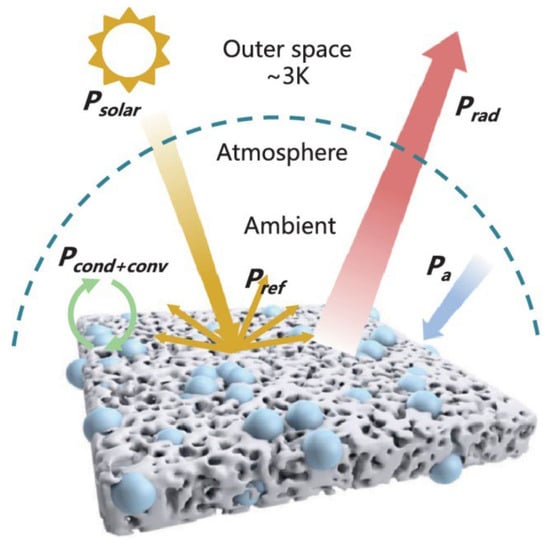
Figure 4.
Schematic representation of passive radiative cooling paint [21].
However, for commercial applications, cost has always been a concern. Thus, researchers have adopted new strategies to achieve higher comfort levels and efficiency through the application of advanced techniques, such as active systems (e.g., HVAC systems, heat pumps) [22] and passive measures (e.g., Trombe walls, greenhouses, solar chimneys, etc.) [16,23,24,25,26]. Passive systems, such as thermal mass integration in buildings, rely on natural heat storage and release without external energy input, whereas active systems, including air conditioning and evaporative cooling, require mechanical or electrical assistance to enhance heat transfer.
Among the most widely tested passive technologies for reducing peak heating and cooling loads and storing energy are the integration of solar thermal energy storage (TES) technology systems [7,27,28]. Incorporating TES technologies into buildings can reduce peak demand by 20–40%, lower energy usage by 14%, cut energy costs by 10–20%, and decrease emissions by 5% [27].
Three types of TES technologies have been widely investigated—sensible heat storage, latent heat storage, and thermochemical heat storage—as detailed in Table 1. Sensible and latent heat storage are the most commonly used technologies in building envelopes due to their safety characteristics and ease of use [28]. Furthermore, for the same storage volume, latent heat storage (LHS) systems offer a higher energy storage density than sensible heat storage (SHS) systems, as a large amount of energy is absorbed or released during the phase change at a constant temperature. Thus, LHS can improve system efficiency while maintaining a stable target temperature [29].
Researchers have focused on phase change materials (PCMs) based on latent heat energy storage as a solution to address energy crisis problems, reduce environmental pollution, and ensure human thermal comfort. PCMs are used to effectively store energy and manage temperature variations, maintaining temperatures within a specific range. This capability enables enhanced thermal regulation and improved energy efficiency in various applications.
3. Operational Processes of Phase Change Materials (PCMs)
The latent TES (LTES) system using phase change materials (PCMs) stores and releases thermal energy through phase transition, which can occur in the form of solid–liquid (S-L), liquid–gas (L-G), or solid–solid (S-S) transformations during charge and discharge cycles [34,35,36].
During the charging cycle, the PCM absorbs heat energy and changes its phase from solid to liquid, with the reaction being endothermic. During the discharging cycle, when energy is needed and released, the material returns to its solid phase (Figure 5), with the reaction being exothermic. Due to the slight volume change, the S-L and S-S phase change materials are the most favored [29,35].
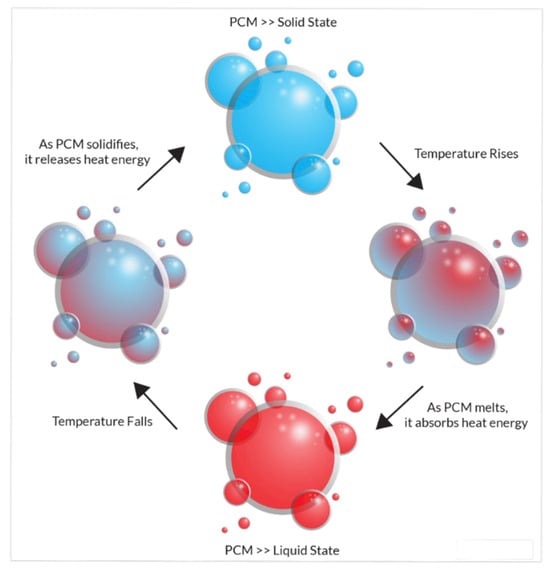
Figure 5.
Mechanisms and processes of phase change materials [36].
PCMs are classified based on their chemical composition and temperature range and are categorized into organic, inorganic, and eutectic materials. Figure 6 provides a list of PCMs available in both organic and inorganic forms [35].
3.1. Integration of Phase Change Materials
As depicted in Figure 7, PCMs can be integrated into various parts of a building, depending on the application. This includes PCM-impregnated floors, roofs, wallboard bricks, ceilings, gypsum panels, windows/façades, solar collectors, etc. [38,39,40,41]. Li et al. [16] provided a detailed illustration showing all possible PCM incorporation points within a building (Figure 8).
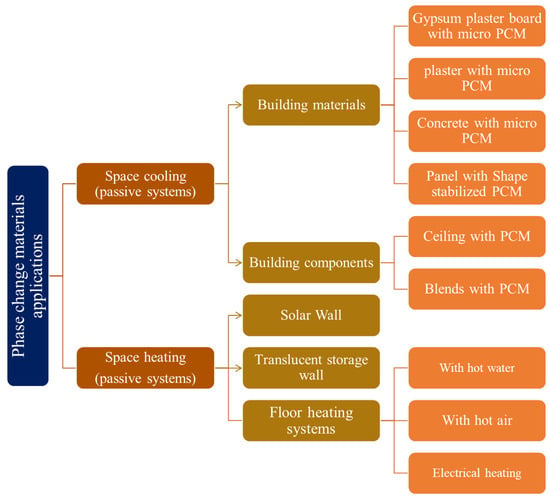
Figure 7.
Various applications of phase change materials in building construction [31].
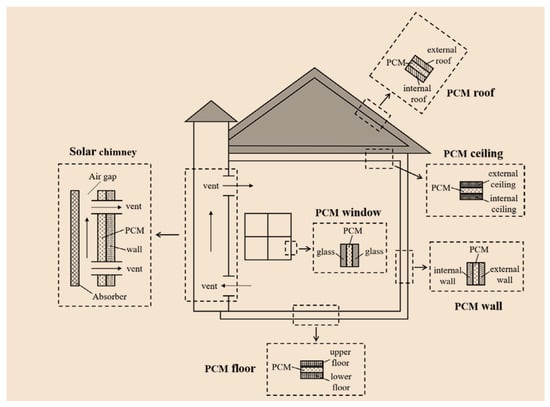
Figure 8.
Potential approach for incorporating phase change materials [39].
3.2. Fundamental Properties of Phase Change Materials
Selecting the optimal PCM for a particular building application is indeed a challenging task, as each material has unique thermal properties that may or may not be suitable for different structural elements: roofs, walls, windows, etc. Table 2 highlights the advantages and limitations of each type of PCM used in building applications [31]. Organic PCMs appear to be very promising due to their favorable melting temperature range and stability. However, it is clear that further enhancements are still needed, especially in areas like thermal conductivity and cost-effectiveness. The use of nanoparticles to improve thermal conductivity and bio-based PCMs as a pathway to reach net-zero CO2 emissions is particularly promising, as these solutions have the potential to make phase change material technology both efficient and sustainable. That said, balancing performance with affordability and environmental impact will remain crucial as we continue to refine these materials for widespread building applications.
The appropriate PCM depends heavily on its thermophysical properties and operating temperature range, along with other desired characteristics. As depicted in Figure 9, each type of PCM has a specific working temperature range, making some more suitable for certain applications than others [35].
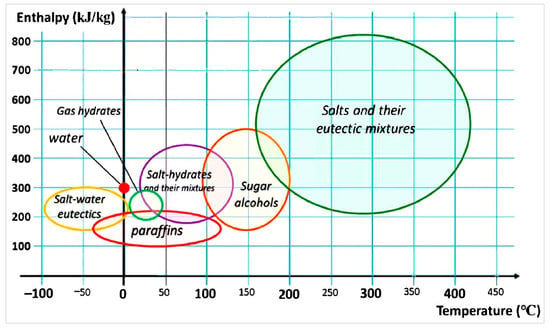
Figure 9.
Operating range of enthalpy and temperature of various PCMs [37].
Before any application, a thermophysical test should be conducted to ensure the suitability of the PCM chosen for the building under study. Different technologies can be used, but the most widely adopted method is the differential scanning calorimetry (DSC). This technique provides information on the PCM’s melting and solidification temperatures, specific heat, enthalpies, and heat storage capacity. Table 3 yields the thermal properties of PCMs commonly used in building applications [35], while Table 4 depicts the most used paraffins and fatty acids for cooling and heating purposes. It can be concluded that for cooling applications in buildings, integrated PCMs should have a melting temperature between 19 °C and 28 °C, whereas for heating applications, the optimal range is between 28 °C to 40 °C [28]. Furthermore, other factors should be considered, like weather conditions—especially in regions with variable climates—building structure, insulation degree, ventilation rate, inner recesses, occupancy profile and number of people, direct solar radiation, heating profile, and more [37,42].

Table 4.
Different types of PCMs: insights into paraffin and fatty acids [27].
Based on their phase transition temperature, fatty acids have proven to be suitable as PCMs for different applications at both low and medium temperatures. For low phase transition temperatures ranging from −20 °C to 5 °C, PCMs are particularly effective in commercial and domestic refrigeration applications. In the range of 5 °C to 40 °C, they can be used for both passive and active cooling and heating applications [42]. However, while fatty acids demonstrate promising thermal properties, challenges such as supercooling, phase segregation, and low thermal conductivity may limit their long-term efficiency and performance.
3.3. Advanced Incorporation Techniques for Phase Change Materials
The incorporation of PCMs into building envelopes contributes to improving thermal comfort and energy management by reducing heat peak and indoor temperature fluctuation. This is owing to their energy storage density, which is 5–10 times higher than that of standard walls, ultimately leading to reduced electricity costs [43]. As depicted in Figure 10, there are four main methodologies for integrating PCMs into building envelope elements: direct incorporation, impregnation, encapsulation, and stabilization [33,44,45,46], each with its own advantages and disadvantages.
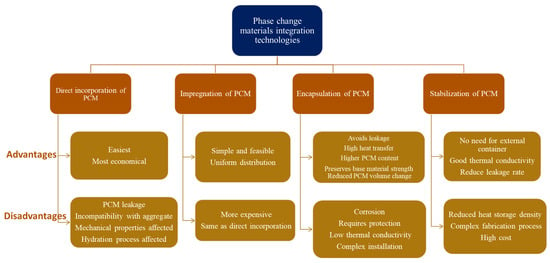
Figure 10.
Advanced technologies for incorporating phase change materials.
Figure 11 shows that PCMs can be integrated into porous construction materials such as bricks or building blocks, or encapsulated in metal or plastic containers through macro-encapsulation [33,45,47,48,49,50,51,52,53]. In some applications, PCMs can be filled into brick cavities or added as one or more separate layers to the wall with proper encapsulation. In this context, Mukram and Daniel [31] investigated various methods for incorporating PCMs into building structures, including using PCM as a separate layer, inserting them into brick cavities, and integrating them into cement mortar for concrete or plastering. They concluded that for optimal thermal performance, the PCM layer should be placed closer to the heat source. However, while this approach enhances heat absorption, it also raises concerns regarding structural integrity, potential leakage, long-term durability, and compatibility with traditional building components. Thus, further studies are needed to balance thermal regulation with material stability for more effective PCM integration.
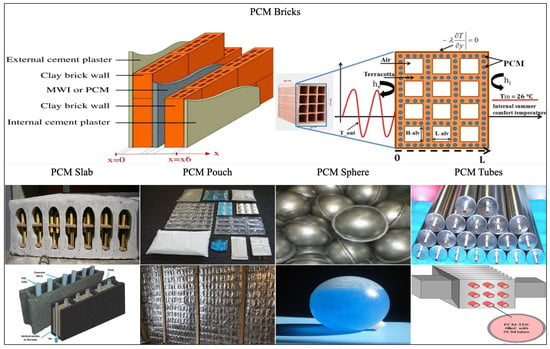
Phase change materials can be incorporated into various applications using different chemical and physical methods to enhance their efficiency and adaptability. They can be integrated through microencapsulation, direct incorporation, or shape stabilization [33,37,54].
3.3.1. Direct Incorporation Methods of Phase Change Materials
Direct integration of PCMs into building materials (e.g., concrete, cement mortar, or gypsum) is considered the simplest, easiest, and most cost-effective integration technique. Feldman et al. [53] proved that directly adding 21–22% organic PCMs to gypsum sheets, along with some additives, significantly enhanced energy storage—up to 10 times more compared to conventional gypsum wallboard. However, the main drawback of this technique is the risk of PCM leakage and the degradation of the mechanical properties of building materials. In particular, it was noticed that leakage could increase the risk of fire [31,43,54,55]. To address these drawbacks, Sun et al. [56] explored a double-layer radiant floor system integrating Na2HPO4⋅12H2O and CaCl2⋅6H2O composite PCMs as high- and low-temperature layers, respectively (Figure 12). They concluded that the incorporation of the PCM layer significantly improved thermal comfort in the test room [1].
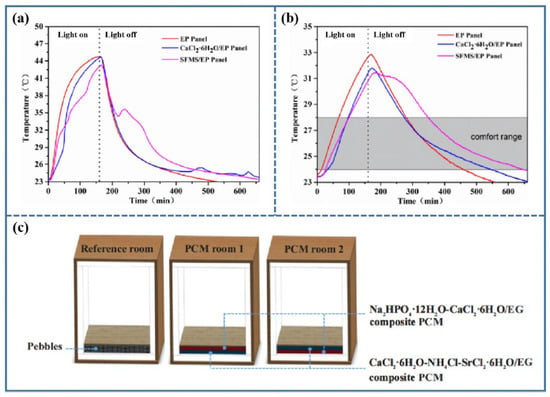
Figure 12.
Experimental model of PCM integrated into the floor [1]. (a) in the indoor center; (b) in the roof of the tested room; (c) schematic of the three tested rooms.
Antar et al. [28] also conducted a numerical simulation using ANSYS 2020 to examine the thermal behavior of a building wall under different weather conditions, testing multiple types of PCMs and placement configurations. The highest thermal performance was achieved using RT-35HC, optimally positioned 1.5 cm from both sides of the wall. Besides, they registered a 3.4 °C decrease in indoor wall temperature and a 66% reduction in overall energy gain during the summer season.
Despite its simplicity, direct incorporation compromises structural integrity, while optimal placement requires precise engineering. These challenges raise concerns about long-term durability and safety—particularly with regard to fire risks and leakage problems. Therefore, future research should focus on enhancing stabilization, encapsulation, and fire resistance to make PCMs more practical and reliable solutions.
3.3.2. Impregnation Technique for PCM
In this technique, building materials such as bricks, concrete, or gypsum board are dipped in a liquid PCM. As a result, the PCM is absorbed through capillarity, permeating the pores of the materials. Although impregnation is still subject to the same risks as direct integration, it is considered a more effective technique [31,43,55,57].
3.3.3. Encapsulation Technique for PCM
To overcome leakage and compatibility problems, the encapsulation technique was developed, in which PCM is enclosed within a protective shell before incorporation. This containment prevents the liquid phase from leaking and isolates it from its surroundings. To ensure compatibility with the construction materials, the shell (or core) must meet specific criteria like corrosion resistance, flexibility, and sufficient strength to prevent the leakage of molten PCM and contamination of the core material. Thus, the heat transfer area and thermal conductivity increase, leading to improved PCM effectiveness. Despite improvements in heat transfer efficiency and PCM performance, encapsulation also introduces complexities, such as reduced thermal storage density, increased costs, and challenges in large-scale applications.
Based on their size, capsules are classified as follows: macro-capsules (diameter larger than 1 mm), including shells, tubes, panels, containers, and plastic bags [58]; micro-capsules (diameter ranging from 1 to 1000 μm), typically used in applications with a temperature range of 10–80 °C; and nano-capsules or nano-spheres (diameter ranging from 1 to 1000 nm) [31,43,55], which have been proven to offer higher thermal stability but face challenges related to degradation and fabrication.
3.3.4. Stabilization Techniques for Phase Change Materials
Shape-stabilized PCM (SSPCM) and foam-stabilized PCM (FSPCM) are two advanced methods developed to enhance PCM integration.
SSPCMs are obtained by impregnating PCMs into porous matrices like expanded vermiculate (EV), expanded perlite (EP), expanded graphite (EG), and carbon nanotubes. Capillary forces, surface tension, and interactions between the PCMs and the matrix stabilize the material, preventing leakage during the phase change process. This method is preferred due to its ability to maintain structural integrity over multiple cycles while also improving thermal conductivity and energy storage performance.
The infiltration of liquid/solid PCMs can be elaborated on using two different techniques: the two-step impregnation method (direct impregnation or vacuum impregnation) and the one-step in situ synthesis technique. Studies have shown that vacuum impregnation enhances the retention rate by up to 50% compared to only 30% with non-vacuum treatment [59].
FSPCM, a newer approach, provides complete retention of the PCM during the melting process, preventing leakage and allowing the retention of a wider variety of PCMs. FSPCMs can be produced either through the natural immersion method or through vacuum incorporation. Although the natural immersion technique is the easiest, its low capacity to retain stored thermal energy makes it less recommended compared to vacuum impregnation. FSPCMs utilize porous inorganic matrices—such as silica-based material, silicon dioxide, clay materials diatomite, perlite, etc.—to contain the PCM during phase transitions [31,43].
Despite their advantages in enhancing stability and thermal performance, both methods are relatively expensive, limiting their adoption in large-scale applications. Therefore, the high material and processing costs raise concerns about their commercial viability.
Shohan et al. [60] gathered the most relevant studies where PCMs were incorporated into various building materials, including bricks, mortar, and concrete. Their analysis, summarized in Table 5, explores different integration methods such as encapsulation and immersion. Shohan et al. [60] highlighted the transition temperature range of each PCM and summarized the key findings of each study, including thermal performance, efficiency, and limitations in large-scale applications (Table 5).

Table 5.
Techniques of PCM integration in buildings [60].
3.4. Change Materials: A Sustainable Approach to Heating and Cooling in Buildings
Phase change materials have gained attention for thermal storage due to their ability to exchange heat with the environment, regulate indoor temperature fluctuations, and enable 24 h energy supply from renewable sources [32]. As summarized in Table 6, their desirable characteristics, such as availability, chemical stability, corrosion resistance, high durability, and higher heat storage capacity, make them a good alternative for energy-efficient applications. Besides, the range of phase transitions often aligns with the range of thermal comfort and offers high energy density with a small storage volume [1,26,28,61,62,63,64].
For cooling purposes, PCMs can be integrated into various systems to enhance energy efficiency and reduce temperature fluctuations. In this regard, Chandel and Agarwal [65,66] summarized the integration of PCMs for cooling photovoltaic panels to enhance system efficiency and improve economic benefits. Maccarini et al. [67] investigated a thermal plant configuration with a heat exchanger integrated with PCM, revealing that it could eliminate conventional cooling systems and reduce energy consumption by approximately 67%. Similarly, Garg et al. [68] tested the PCM-incorporated heat exchanger in a rig chamber, registering a 50% reduction in heat gain and a decrease in average air temperature by over 6 °C while maintaining indoor temperature fluctuation stability. Saffari et al. [69] investigated PCM-based cooling techniques in buildings. As expected, they found that the effectiveness of a specific PCM is highly dependent on climatic conditions, its melting temperature, and occupant behavior. Stritih et al. [67] found that PCM-filled walls can significantly decrease building energy consumption, supporting the goal of zero-energy buildings (ZEB). Meanwhile, Ahangari and Maerefat [70] demonstrated that adding a layer of PCM enhanced thermal comfort by 27.39% in dry climate and 19.04% in semi-arid climate conditions in Iran, based on the Fanger comfort model. Similarly, Ascione et al. [69] evaluated the contribution of PCM integrated into various building components in reducing cooling demand in Mediterranean climates, finding a reduction of up to 11.7% in energy consumption during summertime. Evola et al. [71] assessed the effectiveness of PCMs in improving thermal comfort within lightweight structures during the summer season. They concluded that organic PCMs are more appropriate for temperate climate regions than for hot Mediterranean climate regions. Jin et al. [70] investigated the optimal placement of a thin layer in frame walls to increase thermal mass and reduce peak heat flux through the wall [27]. All the previous research underscores that the effectiveness of PCMs is influenced by various factors, including climatic conditions, PCM thickness, surface area, melting point, etc. Based on these findings, Pasupathy and Velraj [72] and Kuznik et al. [73] emphasize that an appropriate PCM should have a phase change temperature range aligning with the indoor comfort zone, typically between 20 °C and 28 °C.
Canim et al. [33] investigated the integration of PCM-paraffin wax in pumice blocks with distinct percentages of 5%, 10%, and 15%. The optimum results in terms of total energy loads were found when using pumice blocks with 15%. This configuration improved indoor temperature fluctuations by 25% and the average wall time delay by 30%. Also, they registered a decrease in the maximum indoor temperature of 1.5 °C. They ultimately recommended pumice blocks containing PCM as a valuable building material, highlighting its potential to significantly improve energy efficiency. Besides, the use of PCM in building components has shown a quite clear improvement in human thermal comfort, but in most cases, the PCM layer was incorporated into the external wall of the building; thus, limited data was available about cooling energy savings that could be achieved by using PCMs in different parts of the building [63,74].
To facilitate the selection of the proper PCM for a specific application, researchers gathered the main characteristics, as presented in Table 6.
| Thermophysical Properties | Kinetic Properties | Chemical Properties | Economic and Environmental Properties |
|---|---|---|---|
|
|
|
|
4. Phase Change Materials: Addressing Drawbacks and Potential Enhancements
Depending on the solidification or melting temperature of the PCM, most research investigating the integration of a single PCM layer has faced the problem of suitability for only one specific season, i.e., either cooling or heating, but not both. Thus, ongoing investigations aim to find solutions that address both applications. Some researchers have suggested using natural ventilation at night to ensure PCM discharge. Others have studied the concept of integrating two PCM layers into different parts of a building, where each layer is designed to meet the operating conditions of a specific season.
Jin and Zhang [76] conducted a numerical simulation in which they proposed a new double-layered PCM incorporated into the building floor. They revealed that compared to a floor without the PCM, the energy released by the PCM-enhanced floor increased by 41.1% during heating and 37.9% during cooling at peak time.
Likewise, the work of Pasupathy and Velraj [69] highlighted the benefits of using double-layer PCM in roof design. The mathematical model, based on the finite volume method, showed a significant improvement in thermal performance: a single layer of PCM reduced heat gain by 17–26%, whereas a double layer achieved a reduction of 25–35% [73]. However, incorporating a second layer of PCM also induced additional costs and implementation complexity. Rehman et al. [77] also highlighted the effectiveness of multiple layers of phase change materials (PCMs) in improving thermal comfort in buildings. They conducted a numerical study on the integration of a double-layer PCM configuration into brick walls, simulating weather conditions in Islamabad during January and June. By selecting PCMs with melting temperatures of 29 °C and 13 °C, they demonstrated that this configuration improved thermal comfort throughout the year compared to a single-layer system. Similarly, Almeida et al. [72,78] used the ESP-r simulator to model a building wall incorporating multiple PCM layers. Their results confirmed that the addition of several layers improves the building’s thermal performance compared to a single-layer design.
Although these studies demonstrated the positive effect of multilayer PCMs on thermal regulation, they remain limited to specific climatic conditions, numerical simulations, material types, and building configurations. Further experimental validation is required to confirm these results under real-life conditions. In addition, the increased thickness of the roof may pose challenges in terms of architectural integration and compatibility with current building standards [79]. Moreover, the economic impact and technical feasibility of such an approach are not discussed, despite being critical for its adoption in the building sector. Finally, the long-term stability and resistance to repeated thermal cycles of PCMs must be thoroughly examined to ensure the reliability and durability of this solution.
Besides, for thermal management applications in buildings, some researchers have used commercially available PCMs, yet the desirable TES properties are not always achieved during incorporation. Challenges often arise related to the melting point, leakage during the charging process, volume changes, and the compatibility of the PCM container with the wall material. To address these issues, the investigations were divided into two main approaches. The first group of studies reported that these impediments could be overcome by mixing different materials in a certain proportion to obtain a composite PCM with improved thermophysical properties [1,31].
In this context, Sheikholeslami [80], in his research on air conditioning machines using porous media, incorporated a PCM to improve the material’s thermal conductivity. He used paraffin (RT27) combined with nano-sized ZnO particles and found that the required operating time was reduced by 37.15% through the use of porous media.
Mehrizi et al. [29] gathered the most relevant results involving enhancements to building walls using bio-composite PCMs. These results are shown in Table 7.

Table 7.
Enhancements of integrated PCM with bio-composite [29].
The second group of investigations focused on using double-layer PCMs combined with composites to enhance thermal conductivity. In this regard, Sun et al. [56] examined a radiant floor system using a PCM based on two hydrated salts mixed with expanded graphite. The investigation was carried out under both winter and summer weather conditions. The heat storage layer in the floor systems was made from an Na2(HPO)4·12(H2O)-based composite with a melting temperature of 31.3 °C and the cold storage layer was made from a CaCl2·6(H2O)-based composite with a melting temperature of 20.2 °C. The results showed that compared to the reference room, the radiant floor system achieved 2.2 times longer thermal comfort duration during the winter season [78].
5. Commonly Adopted Fundamental Assumptions in Leading Research Studies
These assumptions are commonly used in phase change material (PCM) studies [78], but they have certain limitations that can affect the accuracy of the results:
- Liquid PCM is considered an incompressible and Newtonian fluid.
This simplification is reasonable for many PCMs; however, it may be inaccurate for materials that exhibit non-Newtonian behavior, especially near the melting point. A more detailed examination of the rheological properties of such materials could help refine the models.
- Natural convection of a liquid PCM is neglected.
Natural convection plays an important role in the distribution of heat within the liquid phase of a PCM. By ignoring this, the heat transfer and, therefore, the actual thermal performance of the system may be underestimated. While this assumption might be acceptable for very thin PCM layers, it becomes problematic for larger thicknesses.
- PCM envelope layers are assumed to be thin and have high thermal conductivity, allowing us to overlook their thermal resistance.
Although this assumption simplifies the calculations, it does not always reflect reality—especially when the envelope has significant thermal resistance. In real-world applications, the nature of the encapsulation material can significantly influence thermal storage efficiency.
- Volume changes during solid–liquid phase transitions, heat loss from the TES system, and radiative heat transfer are neglected.
Volume changes during solidification and melting can affect the structure and durability of storage materials. Neglecting these factors could lead to inaccurate predictions of long-term performance.
Thermal losses in the thermal energy storage (TES) system can have a significant impact, especially on long-term storage efficiency. Integrating a thermal loss model improves the accuracy and representativeness of the simulations.
Although these assumptions simplify models and facilitate numerical simulations, they must be carefully justified based on the specific conditions of each study. Experimental validation is essential to evaluate the impact of these approximations and to ensure that the simulation results remain reliable for real-world applications.
6. Ground-Breaking Insights and Practical Recommendations
Due to rapid population expansion and increasing energy demand, the energy crisis remains a major concern for modern society. Projections indicate that fossil fuels will continue to account for 70 to 80% of the world’s primary energy supply, leading to environmental issues like frequent disasters, iceberg melting, global warming, and climate change—problems that are expected to worsen in the coming years. As a result, various research methodologies are being promoted to tackle current environmental and energy challenges. Since the building sector is one of the largest energy consumers—accounting for 30% of the world’s energy consumption [5]—many countries have implemented regulations aimed at enhancing energy efficiency in buildings and reducing the carbon footprint. This has been achieved through the development of low-carbon technologies [60,81] and the use of bio-based products. One proposed solution is to replace or integrate conventional materials with more efficient, eco-friendlier, and biodegradable alternatives [82,83].
Thus, the authors of the present paper advocate a multilayer wall design for buildings that goes beyond the traditional use of multiple layers of PCM or PCM combined with bio-composites. Instead, they suggest an innovative configuration consisting of a single PCM layer sandwiched between two layers of hybrid bio-composite. This arrangement, illustrated in Figure 13, is intended to improve the control of heat propagation through the wall structure.
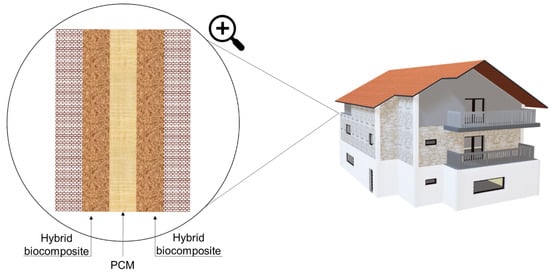
Figure 13.
Shape of the wall suggested by the authors.
The logic of this approach lies in the complementary thermal and environmental benefits offered by PCM and bio-composites. The core layer of PCM functions as an effective thermal energy buffer, storing and releasing latent heat during phase transitions to regulate indoor temperature. The bio-composite outer layers not only serve as structural and insulating elements but also contribute to environmental sustainability by using natural or recycled materials such as coffee grounds.
This multilayer system should
- Improve the thermal inertia of the wall, delay heat transfer, and stabilize indoor temperatures;
- Increase energy efficiency, thereby reducing heating and cooling demands;
- Reduce greenhouse gas emissions by reducing reliance on mechanical HVAC systems;
- Promote waste recovery by incorporating organic by-products into building materials.
This approach is particularly relevant in the context of green building strategies and low-carbon construction solutions.
6.1. Spent Coffee Grounds as PCM
Containing a significant amount of fatty acids, spent coffee grounds (SCGs) have attracted attention as bio-based phase change materials (PCMs) that can be integrated into building walls, ceilings, or roofs.
Coffee is one of the largest agricultural commodities and remains one of the most consumed beverages across the globe. It is deeply integrated into daily human routine. In fact, more than 2.25 billion cups of coffee are consumed every day worldwide, which has resulted in an escalation of coffee production to satisfy market demand. Coffee is considered a natural composite, containing crude fiber (lignin, cellulose, hemicellulose, poly-oligo- and mono-saccharides), lipids (free fatty acids, triacylglycerides, and sterols), nitrogenous compounds, and minerals [84]. Freshly brewed coffee served in cafés, restaurants, and pubs and by coffee producers generates spent coffee grounds (SCGs) as a byproduct of the brewing process. It has been found that one ton of green coffee beans results in approximately 550 to 670 kg of SCG, which is usually sent to landfills, causing environmental issues [42,85]. Indeed, landfilling increases the risk of leaching active biochemicals into the environment. Considering the high organic content of SCGs, disposing of untreated excessive quantities could induce spontaneous combustion, leading to high CO2 and methane emissions, as well as unpleasant odors due to the fermentation process [42].
However, recent studies have shown that compared to conventional organic and inorganic PCMs, SCGs are a promising green alternative to bio-based PCMs. Oil can be extracted from SCGs through different methods such as supercritical fluid extraction (SFE), Soxhlet extraction, ultrasound-assisted extraction (UAE), and microwave-assisted extraction (MAE). The UAE and MAE methods significantly reduce extraction time and solvent consumption. UAE, in particular, has been shown to improve oil yield by disrupting the SCG matrix and facilitating solvent penetration. UAE-derived oils have demonstrated latent heat capacities similar to Soxhlet (~49–50 kJ/kg), but with greater energy efficiency and shorter processing times (~30 min). MAE methods also promise high yields, but can lead to localized overheating that can degrade heat-sensitive compounds. These emerging methods proved that SCGs contain a high value of fatty acids (81.7%), which predominantly consist of linoleic, palmitic, stearic, and oleic acids, making coffee oil a good source of bio-based PCM [42,84]. Fatty acids are considered among organic non-paraffin PCMs, represented by the formula CH3(CH2)2nCOOH, and exhibit significant promise for applications due to their cost-effectiveness, biodegradability, and renewable nature. Compared with paraffins, fatty acids have excellent solid–liquid phase change properties, but they are about three times more expensive [80].
As reported in Table 8, the melting temperature of fatty acids ranges from −5.6 °C to 79 °C, and their latent heat varies between 102 kJ/kg and 212 kJ/kg [80,86]. In this context, the differential scanning calorimeter (DSC) thermograms of the oil extracts (from SCG) analyzed by [42] exhibited relatively broad melting and cooling curves, with a peak melting temperature (Tm) of 4.5 ± 0.72 °C, and a peak freezing temperature (Tf) of −0.98 ± 0.59 °C. Besides, the enthalpy was determined to be 51.15 ± 1.46 J/g. Additionally, the heat capacities of the coffee oil extracts were determined based on temperature variations for both solid (Cp,s (T)) and liquid (Cp,l (T)) phases. It was found that Cp,s (T) varied from 1.3 to 1.5 kJ/kg·K, while Cp,l (T) was nearly temperature-independent at 1.8–1.9 kJ/kg·K. Furthermore, to assess their thermal reliability and stability, the coffee oil extracts were subjected to 100 melt-freeze cycles; the DSC curves displayed endothermic and exothermic peaks identical in shape to those of their uncycled counterparts, indicating that the extracts were thermally stable with largely similar peak positions and intensities. These DSC results support the further exploration of coffee oil as a potential phase change material for thermal energy storage applications. A comparative analysis of SCG-derived PCM with commercialized paraffin and fatty acids has been established and is presented in Table 9. As seen, SCG performance depends on the processing route: pure coffee oil targets cold chain applications (≈5 °C), while SCG/beeswax or SCG-fatty acid composites are suited for building comfort ranges (20–30 °C).

The study conducted by Jin et al. [42] demonstrated the potential of commonly discarded spent coffee grounds (SCGs) as a promising bio-based PCM for thermal energy storage applications. However, as previously reported, the major drawback of this material is its low thermal conductivity. Thus, the heat transfer properties of PCMs can be improved using various methods such as fins, heat pipes, or the incorporation of beeswax. In this context, the authors of the present paper suggest exploring the multilayer technique using hybrid composites due to their favorable thermal characteristics.
6.2. Hybrid Composite
The term “hybrid composite” typically refers to a matrix that is reinforced with two or more types of materials. This approach aims to enhance certain properties of the composite material while reducing production costs by incorporating less expensive reinforcements [88]. In this context, Ben Hamou et al. [89] explored the use of hemp fibers as reinforcements in the production of bio-based (thermoplastic) composites. The increasing interest in such techniques is due to several factors, including the material’s abundance, biodegradable nature, durability, thermal stability, and applications in the aerospace and automotive industries, as well as its recent use in the construction industry. Polypropylene (PP) is the most commonly used thermoplastic (matrix) in natural fiber composites due to its low density, strong mechanical properties, dimensional stability, and high-temperature resistance [88]. Mutjé et al. [90] investigated the polarity of PP and hemp fibers and concluded that both showed hydrophilic behavior. Besides, they found that the surface morphology of hemp fibers improved fiber–matrix adhesion. Khoathane et al. [91] studied the thermal and mechanical properties of hemp fiber-reinforced 1-pentene/PP copolymer composites. The results showed that the thermal stability of the composite surpassed that of both the fiber and the matrix when considered separately.
Thus, hemp fibers have emerged as a strong contender to replace glass fiber due to their superior thermal and mechanical properties. Indeed, Ben Hamou et al. [87] assessed the thermal and mechanical behavior of hybrid hemp/wood fiber-reinforced composites compared to pure hemp fiber and pure wood fiber-reinforced composites. The DSC results are provided in Table 10, which exhibits the melting temperature (Tm) and enthalpy (ΔHm), as well as the crystallization temperature (Tc) and enthalpy (ΔHc). Notably, the melting peak for pure PP was observed at 165 °C and remained largely unchanged in the presence of hemp fibers. However, there was a significant increase in the Tc of the PP matrix from 111 °C to 121 °C, which can be attributed to the nucleating ability of the fibers. This increase in the crystallization rate of hemp fiber-reinforced PP bio-composites further indicates a strong interfacial interaction between the surface of the hemp fibers and the PP molecular chains, facilitated by the coupling agent PP-g-MA [88].

Table 10.
DSC parameters of PP, PP/hemp fiber composites, and hybrid bio-composites [88].
7. Outlook and Emerging Trends for Future Research
To further improve the energy performance of buildings, current research continues to explore advanced techniques for integrating PCM into various structural components. The focus is on optimizing thermal regulation, improving the sustainability of PCM, and developing bio-based or waste-derived materials such as coffee grounds. Emerging trends also focus on multilayer configurations, encapsulation methods, and adaptive thermal systems adapted to climate variability. However, several key factors must be considered to ensure their effectiveness:
- Temperature range suitability
PCMs are effective within a specific temperature range, meaning that their performance is highly dependent on climatic conditions. Some PCMs are better suited to warm climates for passive cooling applications, while others perform more effectively in cold climates for heating purposes. Therefore, it is essential to choose a PCM with an appropriate phase transition temperature that aligns with a building’s thermal requirements.
- Appropriate PCM selection for each application
The efficiency of PCMs depends on several parameters, such as melting and solidification temperature ranges, thermal conductivity, durability, and leak resistance. For instance, materials used for passive cooling must have a phase change temperature that aligns with summer comfort levels, whereas those used for heating applications must be able to efficiently absorb and release heat during the winter.
- Efficient heat transfer during charge and discharge cycles
One of the major challenges in using PCMs is ensuring efficient heat transfer during the charging and discharging phases. Poor heat distribution can reduce storage efficiency and lead to uneven thermal performance throughout the building.
- Managing leakage problems
PCMs can infiltrate adjacent building materials, resulting in thermal losses and structural degradation. To overcome this problem, the use of additives, encapsulation, or bio-based composites can stabilize PCMs and improve their long-term durability.
- Stability and sustainability of PCMs
To ensure efficient use in buildings, PCMs must retain their thermal properties after numerous cycles of melting and solidification. Degradation during repeated thermal cycling could reduce their effectiveness, making encapsulation and chemical stability crucial for sustainable applications. To overcome this problem, incorporating advanced methods like embedding sensor technologies would enable continuous monitoring of the PCM’s thermal performance and structural integrity over time. Such an approach would provide valuable real-time data to help predict degradation and ensure the practical viability of SCG-PCMs for building applications [92].
- Improved thermal conductivity
The low thermal conductivity of many PCMs limits their ability to store and release heat effectively. To remedy this, various strategies can be applied, such as the addition of fins, metal foams, or heat pipes, to optimize heat transfer and maximize PCM efficiency. Also, techniques from semiconductor packaging (micro- or nano-structural heat spreaders) could be adapted in SCG-PCM composites to enhance heat transfer [93].
- Strategic location for optimal efficiency
The placement of PCMs in the building structure plays a key role in their performance. To maximize thermal benefits, they are recommended to be positioned near heat sources (such as sun-exposed surfaces in passive solar heating systems) or in areas with high temperature fluctuations. This ensures efficient heat absorption and release to regulate indoor temperatures.
The integration of PCMs into building materials represents an innovative and effective strategy to improve energy efficiency and reduce reliance on conventional heating and cooling systems. However, the selection of appropriate PCMs and their placement, stability, and thermal conductivity improvement are essential aspects to ensure long-term performance. Future advancements in PCM composites, encapsulation techniques, and thermal management will further optimize their application in the design of sustainable and energy-efficient buildings.
8. Conclusions
Energy security and environmental concerns are driving numerous research initiatives aimed at enhancing energy efficiency, reducing strain on energy infrastructure and cutting carbon dioxide (CO2) emissions. One of the most notable areas of progress is the efficiency enhancement of building heating and cooling systems, achieved through advanced technologies such as heat pumps, solar collectors, chimneys, and thermal energy storage (TES). One of the most promising TES technologies is the integration of phase change materials (PCMs) into various parts of buildings—including walls, floors, ceilings, etc.
This paper provides a summary of research conducted on various PCM applications, offering insights into different types of PCM, methods of encapsulation, their respective weaknesses, and enhancement techniques using additives (such as bio-composites), while also addressing environmental concerns. The aim is to optimize the use of PCMs in building applications. Through this review, it can be concluded that selecting the appropriate PCM for a particular application—whether cooling or heating—requires careful consideration. This choice depends on various factors such as occupancy profile, climate, PCM melting and freezing temperature ranges, thermal conductivity, durability, the building’s insulation properties, and compatibility with construction materials. Incompatibility may lead to leakage or inadequate performance when there is direct contact.
To improve PCM performance, several solutions have been proposed, like incorporation of bio-composites or addressing the encapsulation technique, which help prevent leakage, improve stability, and enhance thermal performance by enclosing the phase change material in a protective core. In the present paper, the authors suggest a new approach involving the use of a multilayered wall. This approach combines two layers of a hybrid bio-composite—specifically, the hybrid hemp/wood fiber-reinforced composite with a PP matrix—along with a layer of PCM made from spent coffee grounds (SCGs).
This review explores the potential of using coffee waste residues as a green and sustainable resource for thermal energy storage, addressing environmental concerns related to landfill disposal. Previous studies on valorizing spent coffee grounds (SCGs) have shown promising results, indicating that coffee oil extracts from SCGs can serve as potential bio-based phase change materials. The extracts contain approximately 60–80% fatty acids with a phase transition temperature of approximately 4.5 ± 0.72 °C and latent heat values of 51.15 ± 1.46 kJ/kg, as determined by differential scanning calorimetry (DSC). FTIR and DSC analyses were conducted on coffee oil extracts following thermal cycling and demonstrated good thermal and chemical stability.
Building on this, an innovative configuration-based multilayer design was suggested, consisting of a single layer of PCM sandwiched between two layers of a hybrid bio-composite. This arrangement aims to improve the control of heat propagation through the wall structure. Although the phase transition of the SCG-PCM (5 °C) seems unsuitable for passive cooling in hot climates (typically requiring 19–28 °C), ongoing research is exploring enhancements to the thermophysical properties of the SCG-PCM by blending it with materials like palm wax (PW), beeswax (BW), or golden soy wax (GW).
Author Contributions
A.H.: Conceptualization, investigation, funding acquisition, writing—original draft, writing—review and editing. F.E.: Investigation, funding acquisition, writing—original draft, writing—review and editing. A.L.: Conceptualization, methodology, supervision, writing—review and editing. M.B.: Conceptualization, methodology, supervision, writing—review and editing. All authors have read and agreed to the published version of the manuscript.
Funding
The authors declare that they have no known competing financial interests or personal relationships that could have appeared to influence the work reported in this paper.
Data Availability Statement
Data sharing is not applicable to this article.
Acknowledgments
We would like to thank the University of Québec in Abitibi Témiscamingue who supported this work.
Conflicts of Interest
The authors declare no conflict of interest.
Abbreviations
The following abbreviations are used in this manuscript:
| Abbreviations | |
| DSC | Differential scanning calorimeter |
| DTG | Derivative thermogravimetric machine |
| EG | Expanded graphite |
| EP | Expanded pearlite |
| EV | Expanded vermiculate |
| FSPCM | Foam-stabilized PCM |
| FTIR | Fourier transform infrared spectroscopy |
| GDP | Gross domestic product |
| HVAC | Heating, ventilation, and air conditioning |
| LHS | Latent heat storage |
| LTES | Latent thermal energy storage |
| MUFA | Monounsaturated fatty acid |
| PCM | Phase change material |
| PUFA | Polyunsaturated fatty acid |
| PVT | Photovoltaic–thermal |
| SCG | Spent coffee ground |
| SDG | Sustainable Development Goals |
| SFA | Saturated fatty acid |
| SHS | Sensible heat storage |
| SSPCM | Shape-stabilized PCM |
| TES | Thermal energy storage |
| TG | Thermogravimetric |
| ZEB | Net Zero Emissions in Building |
| Nomenclature | |
| Cp | Specific heat capacity (kJ/kg·K) |
| K | Thermal conductivity (W/m·K) |
| Tm | Melting temperature (°C) |
| W0 | Weight of extracted oil (g) |
| Wd | Weight of the dried SCGs (g) |
| α | Thermal expansion coefficient |
| ΔH | Latent heat for fusion (kJ/kg) |
| ρ | Density (kg/m3) |
References
- Chen, Z.; Zhang, X.; Ji, J.; Lv, Y. A review of the application of hydrated salt phase change materials in building temperature control. J. Energy Storage 2022, 56, 106157. [Google Scholar] [CrossRef]
- Ritchie, H.; Roser, M.; Rosado, P. Energy. Our World in Data, 27 October 2022. Available online: https://ourworldindata.org/energy-mix (accessed on 19 September 2023).
- Kuczyński, T.; Staszczuk, A.; Gortych, M. Comparison of heavy building envelopes and PCM: Impact on indoor temperature peaks and cooling energy use during heat events. Energy 2025, 325, 136213. [Google Scholar] [CrossRef]
- IEA. Electricity 2025—Analysis. IEA. 14 February 2025. Available online: https://www.iea.org/reports/electricity-2025 (accessed on 12 April 2025).
- IEA. Space Cooling—Energy System. IEA. 2023. Available online: https://www.iea.org/energy-system/buildings/space-cooling (accessed on 4 July 2023).
- Advances in Cold-Climate-Responsive Building Envelope Design: A Comprehensive Review. Available online: https://www.mdpi.com/2075-5309/14/11/3486 (accessed on 21 April 2025).
- Faraj, K.; Khaled, M.; Faraj, J.; Hachem, F.; Castelain, C. Phase change material thermal energy storage systems for cooling applications in buildings: A review. Renew. Sustain. Energy Rev. 2020, 119, 109579. [Google Scholar] [CrossRef]
- Huang, Y.X.; Shu, Z.Y.; Liu, Z.Q.; Cai, Y.; Wang, W.W.; Zhao, F.Y. Transient cooling performance and parametric characteristic of active–passive coupling cooling system integrated air-conditioner, PV-PCM envelope, and ice storage. Energy Build. 2025, 329, 115296. [Google Scholar] [CrossRef]
- Xu, Y.; Zhao, B.; Yu, J.; Yin, X.; Chang, W.S.; Guo, H. Integrating phase-change materials to reduce overheating risk in residential buildings in cold regions of China. Constr. Build. Mater. 2025, 475, 141153. [Google Scholar] [CrossRef]
- IEA. Buildings—Energy System. IEA. 2023. Available online: https://www.iea.org/energy-system/buildings (accessed on 24 June 2024).
- Xu, X.; Mumford, T.; Zou, P.X.W. Life-cycle building information modelling (BIM) engaged framework for improving building energy performance. Energy Build. 2021, 231, 110496. [Google Scholar] [CrossRef]
- Abdulmunem, A.R.; Samin, P.M.; Sopian, K.; Hoseinzadeh, S.; Al-Jaber, H.A.; Garcia, D.A. Waste chicken feathers integrated with phase change materials as new inner insulation envelope for buildings. J. Energy Storage 2022, 56, 106130. [Google Scholar] [CrossRef]
- IEA. Policy database—Data & Statistics. IEA. 4 July 2023. Available online: https://www.iea.org/policies (accessed on 4 July 2023).
- European Comission. 2030 Climate & Energy Framework. 19 September 2023. Available online: https://climate.ec.europa.eu/eu-action/climate-strategies-targets/2030-climate-energy-framework_en (accessed on 19 September 2023).
- National Development and Reform Commission (NDRC), National Energy Administration. China 13th Five-Year Plan for Energy Development|Green Policy Platform. December 2016. (In Chinese). Available online: https://www.greenpolicyplatform.org/national-documents/china-13th-five-year-plan-energy-development-chinese (accessed on 19 September 2023).
- Li, Y.; Nord, N.; Xiao, Q.; Tereshchenko, T. Building heating applications with phase change material: A comprehensive review. J. Energy Storage 2020, 31, 101634. [Google Scholar] [CrossRef]
- Hmida, A.; Slimani, M.E.A.; El Haj Assad, M.; Ben Ali, O. Solar Photovoltaic Thermal Collector as a Cogeneration Energy System: Conception and Recent Development in the Mediterranean Region. In The Handbook of Environmental Chemistry; Springer: Berlin/Heidelberg, Germany, 2023; pp. 1–36. [Google Scholar] [CrossRef]
- Yuan, P.; Duanmu, L.; Wang, Z.; Gao, S.; Zheng, H. Thermal performance of solar-biomass energy heating system coupled with thermal storage floor and radiators in northeast China. Appl. Therm. Eng. 2024, 236, 121458. [Google Scholar] [CrossRef]
- Chen, Y.; Feng, L.; Li, X.; Zoghi, M.; Javaherdeh, K. Exergy-economic analysis and multi-objective optimization of a multi-generation system based on efficient waste heat recovery of combined wind turbine and compressed CO2 energy storage system. Sustain. Cities Soc. 2023, 96, 104714. [Google Scholar] [CrossRef]
- Levitz, E. Can Extremely Reflective White Paint Save the Planet? Intelligencer. 15 July 2023. Available online: https://nymag.com/intelligencer/2023/07/can-extremely-reflective-white-paint-save-the-planet.html (accessed on 19 September 2023).
- Huang, J.; Li, M.; Fan, D. Core-shell particles for devising high-performance full-day radiative cooling paint. Appl. Mater. Today 2021, 25, 101209. [Google Scholar] [CrossRef]
- Aksoy, U.T.; Inalli, M. Impacts of some building passive design parameters on heating demand for a cold region. Build. Environ. 2006, 41, 1742–1754. [Google Scholar] [CrossRef]
- Li, Y.; Huang, G. Development of an integrated low-carbon heating system for outdoor swimming pools for winter application. E3S Web Conf. 2019, 111, 03031. [Google Scholar] [CrossRef]
- Wang, G.; Li, X.; Chang, C.; Ju, H. Multi-objective passive design and climate effects for office buildings integrating phase change material (PCM) in a cold region of China. J. Energy Storage 2024, 82, 110502. [Google Scholar] [CrossRef]
- Ao, C.; Yan, S.; Zhao, X.; Zhang, N.; Wu, Y. Design optimization of a novel annular fin on a latent heat storage device for building heating. J. Energy Storage 2023, 64, 107124. [Google Scholar] [CrossRef]
- Harlé, T.; Hebert, R.L.; Nguyen, G.T.M.; Ledésert, B.A. A composite of cross-linked polyurethane as solid–solid phase change material and plaster for building application. Energy Build. 2022, 262, 111945. [Google Scholar] [CrossRef]
- Tyagi, V.V.; Chopra, K.; Kalidasan, B.; Chauhan, A.; Stritih, U.; Anand, S.; Pandey, A.; Sarı, A.; Kothari, R. Phase change material based advance solar thermal energy storage systems for building heating and cooling applications: A prospective research approach. Sustain. Energy Technol. Assess. 2021, 47, 101318. [Google Scholar] [CrossRef]
- Anter, A.G.; Sultan, A.A.; Hegazi, A.A.; El Bouz, M.A. Thermal performance and energy saving using phase change materials (PCM) integrated in building walls. J. Energy Storage 2023, 67, 107568. [Google Scholar] [CrossRef]
- Mehrizi, A.A.; Karimi-Maleh, H.; Naddafi, M.; Karimi, F. Application of bio-based phase change materials for effective heat management. J. Energy Storage 2023, 61, 106859. [Google Scholar] [CrossRef]
- Cao, V.D.; Pilehvar, S.; Salas-Bringas, C.; Szczotok, A.M.; Bui, T.Q.; Carmona, M.; Rodriguez, J.F.; Kjøniksen, A.-L. Thermal analysis of geopolymer concrete walls containing microencapsulated phase change materials for building applications. Sol. Energy 2019, 178, 295–307. [Google Scholar] [CrossRef]
- Mukram, T.A.; Daniel, J. A review of novel methods and current developments of phase change materials in the building walls for cooling applications. Sustain. Energy Technol. Assess. 2022, 49, 101709. [Google Scholar] [CrossRef]
- Harmen, Y.; Chhiti, Y.; El Fiti, M.; Salihi, M.; Jama, C. Eccentricity analysis of annular multi-tube storage unit with phase change material. J. Energy Storage 2023, 64, 107211. [Google Scholar] [CrossRef]
- Saylam Canım, D.; Maçka Kalfa, S. Development of a new pumice block with phase change material as a building envelope component. J. Energy Storage 2023, 61, 106706. [Google Scholar] [CrossRef]
- Simon, F.; Ruiz-Valero, L.; Girard, A.; Galleguillos, H. Experimental and Numerical Analysis of a PCM-Integrated Roof for Higher Thermal Performance of Buildings. J. Therm. Sci. 2024, 33, 522–536. [Google Scholar] [CrossRef]
- Inside, K. What are phase change materials? KulKote Inside. 21 July 2023. Available online: https://kulkote-inside.com/technical/what-are-pcms (accessed on 28 September 2023).
- Al-Yasiri, Q.; Szabó, M. Incorporation of phase change materials into building envelope for thermal comfort and energy saving: A comprehensive analysis. J. Build. Eng. 2021, 36, 102122. [Google Scholar] [CrossRef]
- Baylis, C.; Cruickshank, C.A. Parametric analysis of phase change materials within cold climate buildings: Effects of implementation location and properties. Energy Build. 2024, 303, 113822. [Google Scholar] [CrossRef]
- Bilal, A.S.S.; Bhutta, S.M.; Mesum, I.U.; Waseem, M.; Munir, M.U.; Almaary, K.S.; Fatima, R. PCM-integrated windows for enhanced passive cooling: An experimental and numerical investigation. Heat Mass Transf. 2025, 61, 27. [Google Scholar] [CrossRef]
- Mao, S.; Liu, Y.; Wu, X.; Zhang, L.; Chen, J.; Zhou, T. Thermal energy storage performance, application and challenge of phase change materials: A review. Energy Storage Sav. 2025, in press. [CrossRef]
- Khakpour, Y.; Seyed-Yagoobi, J. Evaporating Liquid Film Flow in the Presence of Micro-Encapsulated Phase Change Materials: A Numerical Study. J. Heat Transf. 2015, 137, 021501. [Google Scholar] [CrossRef]
- Nader, N.A.; Bulshlaibi, B.; Jamil, M.; Suwaiyah, M.; Uzair, M. Application of Phase-Change Materials in Buildings. Am. J. Energy Eng. 2015, 3, 46. [Google Scholar] [CrossRef]
- Jin Ong, P.; Leow, Y.; Yun Debbie Soo, X.; Chua, M.H.; Ni, X.; Suwardi, A.; Tan, C.K.I.; Zheng, R.; Wei, F.; Xu, J.; et al. Valorization of Spent coffee Grounds: A sustainable resource for Bio-based phase change materials for thermal energy storage. Waste Manag. 2023, 157, 339–347. [Google Scholar] [CrossRef]
- Sawadogo, M.; Duquesne, M.; Belarbi, R.; Hamami, A.E.A.; Godin, A. Review on the Integration of Phase Change Materials in Building Envelopes for Passive Latent Heat Storage. Appl. Sci. 2021, 11, 9305. [Google Scholar] [CrossRef]
- Laasri, I.A.; Charai, M.; Es-sakali, N.; Mghazli, M.O.; Outzourhit, A. Evaluating passive PCM performance in building envelopes for semi-arid climate: Experimental and numerical insights on hysteresis, sub-cooling, and energy savings. J. Build. Eng. 2024, 98, 111161. [Google Scholar] [CrossRef]
- Ding, Y.; Klemeš, J.J.; Zhao, P.; Zeng, M.; Wang, Q. Numerical study on 2-stage phase change heat sink for cooling of photovoltaic panel. Energy 2022, 249, 123679. [Google Scholar] [CrossRef]
- Jia, C.; Geng, X.; Liu, F.; Gao, Y. Thermal behavior improvement of hollow sintered bricks integrated with both thermal insulation material (TIM) and Phase-Change Material (PCM). Case Stud. Therm. Eng. 2021, 25, 100938. [Google Scholar] [CrossRef]
- Laaouatni, A.; Martaj, N.; Bennacer, R.; Lachi, M.; El Omari, M.; El Ganaoui, M. Thermal building control using active ventilated block integrating phase change material. Energy Build. 2019, 187, 50–63. [Google Scholar] [CrossRef]
- Mahdaoui, M.; Hamdaoui, S.; Ait Msaad, A.; Kousksou, T.; El Rhafiki, T.; Jamil, A.; Ahachad, M. Building bricks with phase change material (PCM): Thermal performances. Constr. Build. Mater. 2021, 269, 121315. [Google Scholar] [CrossRef]
- Mechouet, A.; Oualim, E.M.; Mouhib, T. Effect of mechanical ventilation on the improvement of the thermal performance of PCM-incorporated double external walls: A numerical investigation under different climatic conditions in Morocco. J. Energy Storage 2021, 38, 102495. [Google Scholar] [CrossRef]
- Navarro, L.; De Gracia, A.; Castell, A.; Álvarez, S.; Cabeza, L.F. Design of a Prefabricated Concrete Slab with PCM Inside the Hollows. Energy Procedia 2014, 57, 2324–2332. [Google Scholar] [CrossRef]
- Veerakumar, C.; Sreekumar, A. Phase change material based cold thermal energy storage: Materials, techniques and applications—A review. Int. J. Refrig. 2016, 67, 271–289. [Google Scholar] [CrossRef]
- Cao, X.; Wang, Y.; Luo, K.; Wang, L.; Liu, X.; Luan, Y. Energy-Saving potential of radiative cooling and phase change materials in hot Climates: A numerical study. Appl. Therm. Eng. 2025, 268, 125971. [Google Scholar] [CrossRef]
- Feldman, D.; Banu, D.; Hawes, D.; Ghanbari, E. Obtaining an energy storing building material by direct incorporation of an organic phase change material in gypsum wallboard. Sol. Energy Mater. 1991, 22, 231–242. [Google Scholar] [CrossRef]
- Alfy Kamel, J.; Mouris Mina, E.; Moneeb Elsabbagh, A.M. New graphical method for assessing the integration of phase change materials into building envelope. Ain Shams Eng. J. 2023, 14, 102141. [Google Scholar] [CrossRef]
- Sharshir, S.W.; Joseph, A.; Elsharkawy, M.; Hamada, M.A.; Kandeal, A.; Elkadeem, M.R.; Thakur, A.K.; Ma, Y.; Moustapha, M.E.; Rashad, M.; et al. Thermal energy storage using phase change materials in building applications: A review of the recent development. Energy Build. 2023, 285, 112908. [Google Scholar] [CrossRef]
- Sun, W.; Zhang, Y.; Ling, Z.; Fang, X.; Zhang, Z. Experimental investigation on the thermal performance of double-layer PCM radiant floor system containing two types of inorganic composite PCMs. Energy Build. 2020, 211, 109806. [Google Scholar] [CrossRef]
- Huang, Y.; Alekhin, V.N.; Hu, W.; Pu, J. Adaptability Analysis of Hollow Bricks with Phase-Change Materials Considering Thermal Performance and Cold Climate. Available online: https://www.mdpi.com/2075-5309/15/4/590 (accessed on 21 April 2025).
- Hu, Z.; Li, W.; Yang, C.; Huang, H.; Guo, Y.; Ge, F.; Zhang, Y. Thermal performance of an active casing pipe macro-encapsulated PCM wall for space cooling and heating of residential building in hot summer and cold winter region in China. Constr. Build. Mater. 2024, 422, 135831. [Google Scholar] [CrossRef]
- Jeong, S.G.; Jeon, J.; Lee, J.H.; Kim, S. Optimal preparation of PCM/diatomite composites for enhancing thermal properties. Int. J. Heat Mass Transf. 2013, 62, 711–717. [Google Scholar] [CrossRef]
- Shohan, A.A.A.; Ganesan, H.; Alsulamy, S.; Kumar, A.; Almujibah, H.R.; Petrounias, P.; Jeyan, J.V.M.L. Developments on energy-efficient buildings using phase change materials: A sustainable building solution. Clean Techn. Environ. Policy 2024, 26, 263–289. [Google Scholar] [CrossRef]
- Bordoloi, U.; Das, D.; Kashyap, D.; Patwa, D.; Bora, P.; Muigai, H.H.; Kalita, P. Synthesis and comparative analysis of biochar based form-stable phase change materials for thermal management of buildings. J. Energy Storage 2022, 55, 105801. [Google Scholar] [CrossRef]
- Aghoei, M.M.; Astanbous, A.; Khaksar, R.Y.; Moezzi, R.; Behzadian, K.; Annuk, A.; Gheibi, M. Phase change materials (PCM) as a passive system in the opaque building envelope: A simulation-based analysis. J. Energy Storage 2024, 101, 113625. [Google Scholar] [CrossRef]
- Karaoulis, A. Investigation of Energy Performance in Conventional and Lightweight Building Components with the use of Phase Change Materials (PCMS): Energy Savings in Summer Season. Procedia Environ. Sci. 2017, 38, 796–803. [Google Scholar] [CrossRef]
- Chandel, S.S.; Agarwal, T. Review of cooling techniques using phase change materials for enhancing efficiency of photovoltaic power systems. Renew. Sustain. Energy Rev. 2017, 73, 1342–1351. [Google Scholar] [CrossRef]
- Garg, H.; Pandey, B.; Saha, S.K.; Singh, S.; Banerjee, R. Design and analysis of PCM based radiant heat exchanger for thermal management of buildings. Energy Build. 2018, 169, 84–96. [Google Scholar] [CrossRef]
- Saffari, M.; de Gracia, A.; Ushak, S.; Cabeza, L.F. Passive cooling of buildings with phase change materials using whole-building energy simulation tools: A review. Renew. Sustain. Energy Rev. 2017, 80, 1239–1255. [Google Scholar] [CrossRef]
- Stritih, U.; Tyagi, V.V.; Stropnik, R.; Paksoy, H.; Haghighat, F.; Joybari, M.M. Integration of passive PCM technologies for net-zero energy buildings. Sustain. Cities Soc. 2018, 41, 286–295. [Google Scholar] [CrossRef]
- Ahangari, M.; Maerefat, M. An innovative PCM system for thermal comfort improvement and energy demand reduction in building under different climate conditions. Sustain. Cities Soc. 2019, 44, 120–129. [Google Scholar] [CrossRef]
- Ascione, F.; Bianco, N.; De Masi, R.F.; Mastellone, M.; Vanoli, G.P. Phase Change Materials for Reducing Cooling Energy Demand and Improving Indoor Comfort: A Step-by-Step Retrofit of a Mediterranean Educational Building. Energies 2019, 12, 3661. [Google Scholar] [CrossRef]
- Jin, X.; Medina, M.A.; Zhang, X. Numerical analysis for the optimal location of a thin PCM layer in frame walls. Appl. Therm. Eng. 2016, 103, 1057–1063. [Google Scholar] [CrossRef]
- Evola, G.; Marletta, L.; Sicurella, F. A methodology for investigating the effectiveness of PCM wallboards for summer thermal comfort in buildings. Build. Environ. 2013, 59, 517–527. [Google Scholar] [CrossRef]
- Almeida, F.; Zhang, D.; Fung, A.; Leong, W. Investigation of Multilayered Phase-Change-Material Modeling in ESP-R. In Proceedings of the International High Performance Buildings Conference, West Lafayette, IN, USA, 12–15 July 2010; Available online: https://docs.lib.purdue.edu/ihpbc/47 (accessed on 3 July 2023).
- Pasupathy, A.; Velraj, R. Effect of double layer phase change material in building roof for year round thermal management. Energy Build. 2008, 40, 193–203. [Google Scholar] [CrossRef]
- Ait Laasri, I.; Es-Sakali, N.; Outzourhit, A.; Oualid Mghazli, M. Investigation of the impact of phase change materials at different building envelope placements in a semi-arid climate. Mater. Today Proc. 2023, 251. [Google Scholar] [CrossRef]
- Souayfane, F.; Fardoun, F.; Biwole, P.H. Phase change materials (PCM) for cooling applications in buildings: A review. Energy Build. 2016, 129, 396–431. [Google Scholar] [CrossRef]
- Jin, X.; Zhang, X. Thermal analysis of a double layer phase change material floor. Appl. Therm. Eng. 2011, 31, 1576–1581. [Google Scholar] [CrossRef]
- Rehman, A.U.; Sheikh, S.R.; Kausar, Z.; Grimes, M.; McCormack, S.J. Experimental Thermal Response Study of Multilayered, Encapsulated, PCM-Integrated Building Construction Materials. Available online: https://www.mdpi.com/1996-1073/15/17/6356 (accessed on 21 April 2025).
- Arfi, O.; Mezaache, E.H.; Laouer, A. Numerical investigation of double layered PCM building envelope during charging cycle for energy saving. Int. Commun. Heat Mass Transf. 2023, 144, 106797. [Google Scholar] [CrossRef]
- Sheikholeslami, M. Efficacy of porous foam on discharging of phase change material with inclusion of hybrid nanomaterial. J. Energy Storage 2023, 62, 106925. [Google Scholar] [CrossRef]
- Sharma, R.K.; Ganesan, P.; Tyagi, V.V.; Metselaar, H.S.C.; Sandaran, S.C. Developments in organic solid–liquid phase change materials and their applications in thermal energy storage. Energy Convers. Manag. 2015, 95, 193–228. [Google Scholar] [CrossRef]
- Zhang, C.; Chen, W.H.; Ho, S.H. Economic feasibility analysis and environmental impact assessment for the comparison of conventional and microwave torrefaction of spent coffee grounds. Biomass Bioenergy 2023, 168, 106652. [Google Scholar] [CrossRef]
- Marwan, M.; Indarti, E.; Bairwan, R.D.; Khalil, H.P.S.A.; Abdullah, C.K.; Ahmad, A. Enhancement micro filler spent coffee grounds in catalyst—Chemically modified bast fibers reinforced biodegradable materials. Bioresour. Technol. Rep. 2024, 25, 101723. [Google Scholar] [CrossRef]
- Moshood, T.D.; Nawanir, G.; Mahmud, F.; Mohamad, F.; Ahmad, M.H.; AbdulGhani, A. Sustainability of biodegradable plastics: New problem or solution to solve the global plastic pollution? Curr. Res. Green Sustain. Chem. 2022, 5, 100273. [Google Scholar] [CrossRef]
- Massaya, J.; Prates Pereira, A.; Mills-Lamptey, B.; Benjamin, J.; Chuck, C.J. Conceptualization of a spent coffee grounds biorefinery: A review of existing valorisation approaches. Food Bioprod. Process. 2019, 118, 149–166. [Google Scholar] [CrossRef]
- Miladi, M.; Martins, A.A.; Mata, T.M.; Vegara, M.; Pérez-Infantes, M.; Remmani, R.; Ruiz-Canales, A.; Núñez-Gómez, D. Optimization of Ultrasound-Assisted Extraction of Spent Coffee Grounds Oil Using Response Surface Methodology. Processes 2021, 9, 2085. [Google Scholar] [CrossRef]
- Sarier, N.; Onder, E. Organic phase change materials and their textile applications: An overview. Thermochim. Acta 2012, 540, 7–60. [Google Scholar] [CrossRef]
- Yoo, J.; Chang, S.J.; Wi, S.; Kim, S. Spent coffee grounds as supporting materials to produce bio-composite PCM with natural waxes. Chemosphere 2019, 235, 626–635. [Google Scholar] [CrossRef]
- Ben Hamou, K.; Kaddami, H.; Elisabete, F.; Erchiqui, F. Synergistic association of wood/hemp fibers reinforcements on mechanical, physical and thermal properties of polypropylene-based hybrid composites. Ind. Crops Prod. 2023, 192, 116052. [Google Scholar] [CrossRef]
- Wibowo, A.C.; Mohanty, A.K.; Misra, M.; Drzal, L.T. Chopped Industrial Hemp Fiber Reinforced Cellulosic Plastic Biocomposites: Thermomechanical and Morphological Properties. Ind. Eng. Chem. Res. 2004, 43, 4883–4888. [Google Scholar] [CrossRef]
- Mutjé, P.; Lòpez, A.; Vallejos, M.E.; López, J.P.; Vilaseca, F. Full exploitation of Cannabis sativa as reinforcement/filler of thermoplastic composite materials. Compos. Part A Appl. Sci. Manuf. 2007, 38, 369–377. [Google Scholar] [CrossRef]
- Khoathane, M.C.; Vorster, O.C.; Sadiku, E.R. Hemp Fiber-Reinforced 1-Pentene/Polypropylene Copolymer: The Effect of Fiber Loading on the Mechanical and Thermal Characteristics of the Composites. J. Reinf. Plast. Compos. 2008, 27, 1533–1544. [Google Scholar] [CrossRef]
- Zabihollah, A.; Shi, Y. Reliability Analysis of Residential Buildings Under Hurricane Using Embedded FBG Sensors: Remaining Useful Lifetime Analysis. J. Opt. Photonics Res. 2025; onine first. [Google Scholar] [CrossRef]
- Wu, T.; Shen, J.; Zou, J.; Wu, P.; Liao, Y. Semiconductor Laser Packaging Technology: Thermal Management, Optical Performance Enhancement, and Reliability Studies. J. Opt. Photonics Res. 2024; onine first. [Google Scholar] [CrossRef]
Disclaimer/Publisher’s Note: The statements, opinions and data contained in all publications are solely those of the individual author(s) and contributor(s) and not of MDPI and/or the editor(s). MDPI and/or the editor(s) disclaim responsibility for any injury to people or property resulting from any ideas, methods, instructions or products referred to in the content. |
© 2025 by the authors. Licensee MDPI, Basel, Switzerland. This article is an open access article distributed under the terms and conditions of the Creative Commons Attribution (CC BY) license (https://creativecommons.org/licenses/by/4.0/).
